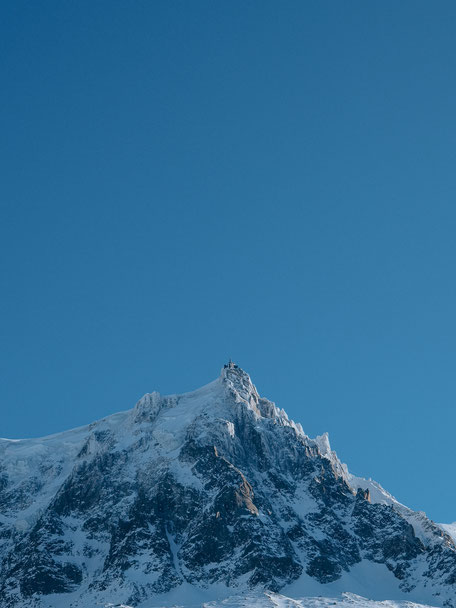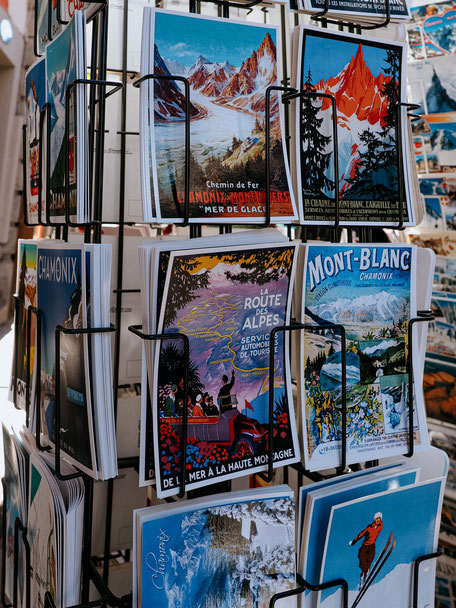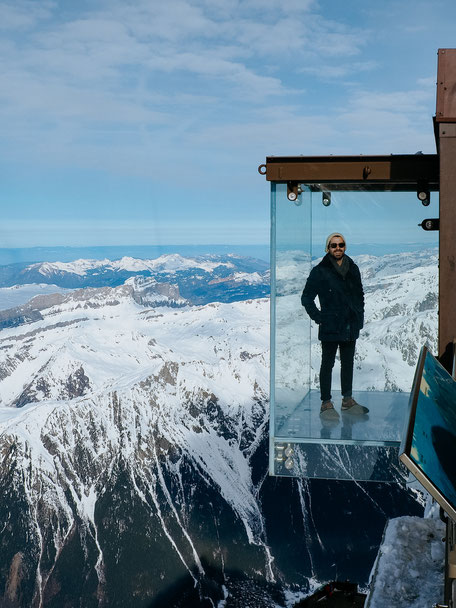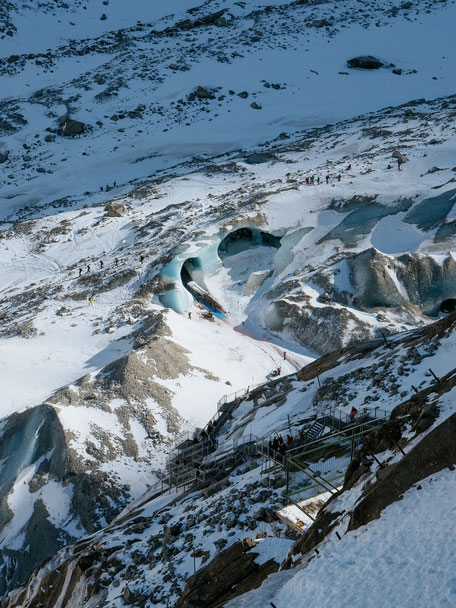Discover the awe-inspiring wonders of Chamonix with our guide to the top attractions: the Aiguille du Midi and the Mer de Glace. Prepare to be enchanted by the majestic beauty of these iconic Alpine destinations.
Welcome back to our Chamonix blog series! We're thrilled to have you join us for the next chapter of our journey in this captivating alpine destination. Building on the excitement of our previous adventures, we're eager to delve deeper into the enchanting wonders of Chamonix. From the towering peaks of the Aiguille du Midi to the icy majesty of the Mer de Glace, there's still so much more to discover and share with you! So come along as we continue to explore and uncover the hidden gems that await us in this breathtaking mountain paradise!
Our comprehensive travel guide has you covered with all the insider tips you need to make the most of your visit. Plus, if you're extending your stay and craving more Chamonix adventures, don't forget to check out our other post, where we spill all the details on what to see and do in the area (you can find it here).

IN THIS GUIDE
1. General information
2. History
3. Aiguille du midi
4. Mer de Glace
5. Getting there
6 Staying there
7. Eating there
8. Final thoughts
GENERAL INFORMATION
Welcome to Chamonix, the stunningly beautiful heart of the Alps and one of the most picturesque places in the region! It's home to the highest peak in Europe: Mont-Blanc, which towers at an impressive 4,809 meters (15,780 ft). As the roof of Europe, you simply can't leave without visiting its top attractions: the Aiguille du Midi and the Mer de Glace!
To make the most of your stay in Chamonix, we highly recommend purchasing the Mont Blanc Unlimited Pass. This pass is an absolute must-have if you want to explore the Aiguille du Midi, the Mer de Glace, or spend a day skiing. For only 65 EUR per person, the one-day pass gives you access to all the attractions and ski areas in Chamonix, as well as public transportation.
However, if you're not keen on heights or prefer not to visit these attractions, don't worry! There are plenty of charming streets to explore in the village of Chamonix, and we highly recommend checking it out. It's definitely a must-see!
| For more information about Chamonix, check our post here |



HISTORY OF CHAMONIX
Chamonix's history can be traced back to the 11th century when it was a part of the feudal domain of the House of Savoy. However, due to its harsh climate and isolation, the town didn't gain much historical significance until the 18th century. It was in this century that two Englishmen, Richard Pococke and William Windham, visited the valley in 1741 and published an article about its stunning natural beauty. This sparked a surge of visitors eager to explore the picturesque village, and Chamonix began to gain prominence as a tourist destination.
Over time, the tourism industry in Chamonix grew, starting with Alpine mountain guides who led visitors on adventurous expeditions. Later, hotels and a ski station were developed to cater to the increasing number of tourists. In 1924, Chamonix had the honor of hosting the first Winter Olympic games, which not only boosted its international fame but also helped to establish it as a classy, old-style ski resort that we know and love today.
From humble beginnings as a small feudal town, Chamonix has evolved into a world-renowned tourist destination with a rich history and stunning natural beauty.



AIGUILLE DU MIDI
GENERAL INFORMATION
The Aiguille du Midi has been an incredibly popular destination for over six decades, attracting countless visitors from all over the world, and it remains one of the most sought-after and highly-visited attractions in the area. With a convenient 20-minute cable car ride, you can ascend to a breathtaking height of 3,842 meters (12,605 ft), where you'll be treated to stunning views of the surrounding snow-capped peaks and awe-inspiring alpine landscapes.
While the duration of your stay at the Aiguille du Midi is entirely up to you, we suggest setting aside a minimum of three hours to truly savor the entire experience. With numerous panoramic terraces to discover and plenty of informative displays to peruse (check map here), you'll want to take your time and soak in all the beauty that this remarkable destination has to offer.
Moreover, the Aiguille du Midi serves as the launching point for the descent of the Vallée Blanche, as well as the Panoramic Mont-Blanc cable car that crosses the Giant Glacier to the Helbronner Point on the Italian side at an altitude of 3,462 meters (11,358 ft), providing breathtaking views of the Aosta Valley and Piedmont. The Panoramic Mont-Blanc is a 5-km long gondola that takes you to the Italian side of the Mont Blanc massif. It's important to note that it's closed during winter and that an ID is required. Additionally, it is not included in the Mont-Blanc Unlimited Pass.
| Opening hours |
daily from 7.30 a.m. to 5.30 p.m.
(please check on the website here)
| Admission - 67 EUR (round-trip) |

PRACTICAL TIPS
PURCHASE YOUR TICKET WELL IN ADVANCE | To save time and avoid long queues, we recommended that you purchase your tickets well in advance. We found it very convenient to buy ours directly at the Chamonix Tourist office.
CONSIDER WAKING UP EARLY | As we read on several blog posts, the cable car can get quite crowded, which can be a frustrating
experience. To avoid queuing, we recommend arriving as early as possible and trying to catch one of the first scheduled cable cars.
GO ON A WEEKDAY | To fully enjoy your visit, we suggest avoiding weekends and school holidays by planning to visit the Aiguille du Midi on a weekday. Due to limited capacity, the attraction can become overcrowded on weekends.
MAKE SURE THE WEATHER CONDITIONS ARE GOOD | To fully appreciate the breathtaking views, it's important to check that the weather conditions are optimal. Clear skies
are necessary to avoid disappointment and ensure that you can fully take in the surrounding scenery. To confirm current visibility, live views can be checked here.
DRESS UP WITH WARM CLOTHES | We highly recommend dressing warmly for sub-zero temperatures, even in summer, as temperatures at the top can drop significantly (around -20°C
in winter). Additionally, there are heated indoor areas at the Aiguille du Midi, allowing you to take refuge from the cold if needed.
MAKE SURE TO BE IN GOOD HEALTH | Despite being young and in relatively good shape, we still felt the effects of the
altitude at the top section. Everyday activities such as climbing stairs left us easily breathless. It's not uncommon for people to experience dizziness or lightheadedness during the ascent, so
take your time to acclimate yourself to the environment.


HISTORY OF THE AIGUILLE DU MIDI
How did the Aiguille du Midi get its name? It's all thanks to its position! Before Chamonix had a clock, locals used the mountains as landmarks to tell the time. And around midday, they noticed the sun shining directly on the peak we now know as the Aiguille du Midi. The name "Agouelye de Mi-Jorn" in Savoyard was later translated into the mythical "Aiguille du Midi".
In the early 1900s, engineers Wilhelm Feldmann and Emil Strub had a vision of connecting Chamonix to the Aiguille du Midi using funiculars and mountain lifts. The first cable car was constructed in two sections between 1909 and 1927, with the second section reaching 2,404 meters at the foot of the Aiguille du Midi. But as it didn't reach the summit, a third section had to be built. Construction started in 1938 but was halted during WWII and replaced by the more direct route we use today.
The modern cable car we know today was built in just five years from 1951 to 1955, with the first cable car used to transport workers and tools. By 1955, the second section of the cable car had been completed, enabling visitors to reach the summit, and thus becoming the highest cable car in the world during that era.

EXPLORING THE AIGUILLE DU MIDI
The Aiguille du Midi is made up of two sections: the first taking you to the Plan de l'Aiguille at 2,317 meters (7,706 ft), and the second elevating you to the upper station at 3,777 meters (12,392 ft). The second section is unique because it was constructed without any supporting pillars, making it an impressive architectural feat for its time in 1949. At that time, it was also the world's longest and highest cable car at 3 kilometers without a pylon.
After a scenic 20-minute ride, you'll arrive at the summit with breathtaking views all around you! It's a truly liberating experience with a sense of vastness that opens up an endless horizon before your very eyes. Mother nature puts on an incredible spectacle that you won't want to miss!



FROM ONE PANORAMIC TERRACE TO ANOTHER
At the top, there are numerous panoramic viewpoints that are worth exploring. You can begin by visiting the "History Area," which provides an in-depth look at the construction of this marvel of engineering. Here, you can see how the lift system works through a glass window and watch a thrilling video of a flyover of the Alps mountains in the new "Ascent Area."
The Aiguille du Midi's facilities feature multiple terraces with awe-inspiring views of the valley and surrounding peaks. The first two panoramic terraces sit just above the cable car station, while the bridge grants access to the main part of the complex. Although unremarkable from above, the bridge reveals a dizzying void below when viewed from a different angle.
The tunnels at Aiguille du Midi were carved directly into the mountain itself, and the left path leads to the access point that mountaineers and skiers use to descend the steep and highly exposed ice ridge onto the glacier below. Be sure to check out the snow-carved passage tunnels, as they are an impressive detail not to be missed!





THE PIPE
One of the newest features of the Aiguille du Midi complex, built in 2016 to celebrate its 60th year of operation, is a 32-meter long steel and glass pipe. This pipe completes the 360º path around the peak and provides unique views in all directions with its five windows.
After crossing the Pipe, you'll arrive at the "Cosmiques terrace" which boasts comfortable benches and larger windows to sit and relax while admiring the stunning views of Vallée Blanche and the Cosmiques Ridge. Additionally, there's a current exhibition called the "Hypoxia level" that explains the effects of oxygen reduction in high altitudes on the human body.
Finally, it's time to head back to the Aiguille du Midi tunnel and take the lift, the last step in the journey that will bring you to the peak at an incredible altitude of 3,842 m (12,605 ft)!




STEP INTO THE VOID
At an altitude of 3,842 m (12,605 ft), the "Summit Terrace" is the highest point of the Aiguille du Midi complex, and it's the closest you can get to Mont-Blanc on a lift system. From this vantage point, you'll be treated to stunning views of all the surrounding peaks, the snow, and the glacier, making it an unforgettable experience. And there's one final attraction to cap it all off: Step Into The Void!
If you need to warm up, there's a sheltered area on the top terrace where you can still enjoy the view through the windows. And if you're feeling brave enough, you can queue up for the unique experience of stepping into a small chamber made of glass with a glass floor and ceiling! The Step Into The Void is made of 3.6 cm thick glass panels, offering a clear panoramic view in all directions, including the 1,000 meters (3,280 ft) of free air directly beneath your feet! Don't worry about the weight; the chamber can hold up to 1,500 kg. However, cameras aren't allowed inside, but a staff member will take pictures with your equipment instead. If you want better shots, a valuable tip is to have someone waiting for your turn from the terrace outside to take your picture from a different perspective, showing you floating above the valley.
The facilities at Aiguille du Midi have been designed to immerse visitors in the surrounding mountains continually. Despite having limited time since we wanted to explore the Mer de Glace on the same day, the experience at Aiguille du Midi was unforgettable. It's a moment that neither I nor Thomas will ever forget!



MER DE GLACE
1. TRAIN DU MONTENVERS
The journey to the Mer de Glace glacier begins at the Montenvers train station, situated just behind the Chamonix one. The vintage-looking red railway trains will take you on a 20-minute ascension through the forest, tunnels, and viaducts. As you ascend, you'll get occasional glimpses of the valley below, but the most magnificent sight is yet to come. Once you reach the top, at an altitude of 1,913 m (6.276 ft), the Mer de Glace glacier will unfold below you, surrounded by towering mountain peaks (you can check the Montenvers area map here).
Upon arrival, you can explore various facilities at the top, including a restaurant with a terrace overlooking the glacier, and the Crystal Museum with a remarkable collection of gems and crystals from the massif. The iconic Refuge du Montenvers Hotel, which opened in 1880, is also located here. This resort was the first to welcome mountaineers visiting the glacier to explore this wonder of nature. It is noteworthy that back then, the glacier reached the same level as the hotel. However, with the effects of climate change, the glacier has significantly reduced in size. To reach the glacier today, visitors need to take a lift down and then descend hundreds of steps.
| Opening hours - daily from 10 a.m. to 4 p.m.
(please check on the website here) |
| Admission - 20 EUR (round-trip) |



2. MER DE GLACE
The Mer de Glace glacier is a breathtaking wonder of nature, but it's also a somber reminder of the effects of climate change. Located on the north face of the Alps, the glacier is formed from the accumulation of snow during winter, which overcomes its melting during summer, over centuries. With its own weight and a process of melting and refreezing, the snow transforms into a thick layer of ice. The glacier is actually a combination of two different glaciers, Géant and Leschaux, which flow from the Tacul massif of the Mont-Blanc.
The Mer de Glace glacier, which used to be visible from Chamonix, has an average thickness of 200 meters. However, it has been melting and retreating at an alarming rate since the end of the 20th century. As we make our way down to the glacier to access the Ice Cave, the effects of the melting glacier are visible. While in 1988, visitors could reach the glacier in just three steps from the bottom of the lift, it now requires going down almost 600 steps. Along the way, plaques show the level of the glacier over the years, serving as a sad and live testimonial of the impact of global warming on the glacier.
Despite the tragic impact of climate change on the Mer de Glace glacier, it remains a must-visit destination for its unique and awe-inspiring beauty. The stunning views of the glacier and the surrounding mountains, coupled with the fascinating Crystal Museum and the historic Refuge du Montenvers Hotel, make the journey to the glacier a memorable experience!



3. ICE CAVE
Entering the ice cave to witness its interior was an experience unlike any other we have had in our lifetime. The moment we stepped into the first gallery, we were immediately struck by the otherworldly feel of being surrounded by solid blue ice walls. As we continued on, we couldn't help but notice the various objects trapped within the ice, including rocks, leaves, and even pieces of wood that have been preserved for decades or even centuries. This family-run ice cave business, which began in 1946, is a testament to the ingenuity of humans to create unique experiences in nature. Each winter, they carve out a new cave with new features like ice sculptures, an ice bar, and even an ice throne.
However, despite their creativity and perseverance, the future of this family business is in danger. While digging to build the ice cave for the 2019 season, they hit rock bottom, quite literally. This event raised an alarm about the rapid pace at which global warming is affecting our planet and how it endangers not only this family business, but also the future of our planet!



TRAVEL ESSENTIALS
GETTING THERE
To reach Chamonix, the nearest airport is located in Geneva, which is approximately 100 km away. There are several options to travel from the airport to Chamonix, and one of them is by taking a bus. Many bus companies offer transfers from Geneva Airport to Chamonix, and we chose Swiss Tours, which has four departures per day. The one-way cost varies from 10 to 15 EUR, and the journey takes around 1 hour and 10 minutes. This is an affordable and convenient way to get to Chamonix from the airport.
STAYING THERE
Chamonix offers a plethora of accommodation options, but keep in mind that prices fluctuate depending on the season. During peak periods, such as Christmas and New Year, rates can skyrocket. It is recommended to book well in advance and avoid French school holidays if possible. For our stay, we opted for an Airbnb, which provided a charming chalet just a short 10-minute walk from the city center. This cozy nest provided an amazing view of the Aiguille du Midi and cost around 100 EUR per night, with a minimum stay of 2 nights. We suggest staying for at least 3 nights to fully experience everything Chamonix has to offer.
EATING THERE
Chamonix is not only famous for its stunning landscapes and skiing, but also for its delicious local cuisine. The mountainous region is known for its hearty dishes that are perfect for warming up after a day on the slopes. Traditional dishes often feature ingredients such as cheese, potatoes, and cured meats, with influences from both French and Swiss cuisine. Below is a list of the restaurants where we enjoyed delicious food in Chamonix:
- Le Monchu: This restaurant comes highly recommended. It's a cozy and intimate place with a rustic atmosphere, and the menu features traditional French dishes with a modern twist. Some of their specialties include the tartiflette and the slow-cooked beef cheek. Prices range from 20-30 EUR for a main course;
- La Calèche: This restaurant is also a good choice, but keep in mind that it can be a bit pricey and touristy. That said, their raclette is definitely worth trying, and the portions are generous (28.50 EUR per person). Other dishes on the menu include fondue and steak;
- Elevation 1904: This is a great spot for a tasty and affordable lunch. The restaurant offers a variety of local dishes, including the Crozets pasta gratin with Morteau sausage and farm cheese, which is a must-try. Prices range from 10-14 EUR for a main course;
- La Maison du Burger: If you're looking for a quick bite on the go, this place is perfect. They have an extensive selection of burgers, including local options with cheese from the region. Prices range from 6-15 EUR;
- Don't miss out on trying the local beer from La Brasserie du Mont-Blanc, which can be found in most restaurants and bars in the ski resort. We recommend the La Blonde and La Rousse varieties. Prices vary depending on the establishment.
From traditional French fare with a modern twist to indulgent raclette and local beer, savor the essence of the Alps with every bite.
FINAL THOUGHTS
Chamonix serves as the gateway to a magnificent natural park, evident from the moment one arrives in the town and gazes upon the mountains enveloping it. The feeling of being surrounded by the highest peaks in Western Europe is an experience not to be missed! If you plan on extending your stay in Chamonix and wish to explore more of the area, we suggest referring to our other post here, which provides comprehensive information on visiting the village of Chamonix and skiing at the Mont-Blanc Natural Resort.
It's time for you to share your own insights, experiences, and recommendations for visiting these two popular attractions in Chamonix. Have you had the chance to explore them already? What were your thoughts?










